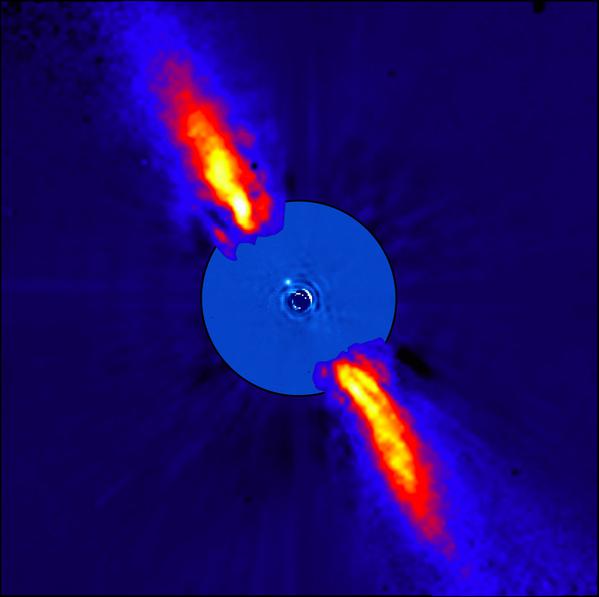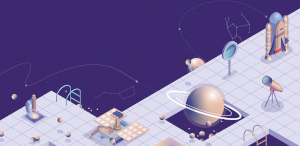This page describes an image beta Pictoris b
Image caption:
This composite of two images shows the planet beta Pictoris b and a disk of material both of which orbit the young star beta Pictoris. Both are taken in infrared light. The inner image was one of the first pictures taken of a planet around another star (an exoplanet). This image was made using a technique called adaptive optics which removes the blurring effect of the Earth's atmosphere that spreads out a star's light. The star's light is then concentrated tightly enough that it can be hidden behind a blocking circle (shown here in black) called a coronagraph. The ripples around this are artifacts of the imaging process. Beta Pictoris b, a gas giant planet about twelve times the mass of Jupiter, appears as a dot above and to the left of the black circle.
The outer image shows the thermal emission from the warm disk of material surrounding the young star beta Pictoris. As we are viewing this disk edge-on it appears as a line. This disk of gas and dust provided the material to form beta Pictoris b.
Scroll to captions in other languages
Image credit:
ESO/A.-M. Lagrange et al. Credit Link
Related glossary terms:
Adaptive Optics
, Exoplanet
, Planet Formation
Categories:
Exoplanets & Astrobiology
Image license: Creative Commons Attribution 4.0 International (CC BY 4.0) Creative Commons Attribution 4.0 International (CC BY 4.0) icons
The media file captions presented on the OAE website were written, translated and reviewed by a collective effort from the OAE, the OAE Centers and Nodes, the OAE National Astronomy Education Coordinators (NAECs) and other volunteers. You can find a full list of credits for our translation project here. All media file captions are released under a Creative Commons CC BY-4.0 license and should be credited to "IAU OAE". The media files themselves may have different licenses (see above) and should be credited as listed above under "credit".
If you notice a factual error in this caption or an error in any of its translations then please get in touch.
Captions in Different Languages:
Image caption: Ce composite de deux images montre la planète beta Pictoris b et un disque de matière, tous deux en orbite autour de la jeune étoile beta Pictoris. Les deux images sont prises en lumière infrarouge. L'image intérieure est l'une des premières images prises d'une planète autour d'une autre étoile (une exoplanète). Cette image a été réalisée à l'aide d'une technique appelée optique adaptative qui supprime l'effet de flou de l'atmosphère terrestre qui étale la lumière d'une étoile. La lumière de l'étoile est alors suffisamment concentrée pour être cachée derrière un cercle de blocage (ici en noir) appelé coronographe. Les ondulations autour de ce cercle sont des artefacts du processus d'imagerie. Beta Pictoris b, une planète géante gazeuse dont la masse est environ douze fois supérieure à celle de Jupiter, apparaît comme un point au-dessus et à gauche du cercle noir.
L'image extérieure montre l'émission thermique du disque de matière chaude entourant la jeune étoile Beta Pictoris. par la tranche, il apparaît sous forme d'une ligne. Ce disque de gaz et de poussière a fourni la matière nécessaire à la formation de beta Pictoris b.
Image credit: ESO/A.-M. Lagrange et al.
Related glossary terms: Exoplanète , Optique adaptative , Planet Formation Caption translation status: Not yet approved by a reviewer
Caption translators: Rulx Narcisse
Image caption: Questa composizione di due immagini mostra il pianeta beta Pictoris b e un disco di materiale che orbitano attorno alla giovane stella beta Pictoris. Entrambe le immagini sono riprese nella luce infrarossa. L'immagine interna è una delle prime di un pianeta intorno ad un'altra stella (un esopianeta). L'immagine è stata realizzata con una tecnica definita ottica adattiva, che elimina l'effetto di sfocamento dovuto all'atmosfera terrestre che diffonde la luce della stella. La luce della stella viene concentrata a sufficienza da poter essere nascosta dietro uno schermo circolare (in nero) chiamato coronografo. Le increspature intorno a questo cerchio sono prodotte dal processo di analisi dell'immagine. Beta Pictoris b, un pianeta gigante gassoso di massa circa dodici volte superiore a quella di Giove, appare come un punto in alto a sinistra del cerchio nero.
L'immagine esterna mostra l'emissione termica del disco caldo di materiale che circonda la giovane stella beta Pictoris e si presenta come una linea poiché lo vediamo di profilo. Questo disco di gas e polvere ha fornito il materiale per la formazione di beta Pictoris b.
Image credit: ESO/A.-M. Lagrange et al.
Related glossary terms: Esopianeta , Formazione dei pianeti , ottica adattiva Caption translation status: Approved by a reviewer
Caption translators: Giuliana Giobbi
Caption reviewers: Rosa Valiante, Silvia Casu, Raffaella Ferretti, Anna Wolter
Image caption: 这幅图像由两张照片合成,显示了系外行星老人增四b和一个物质盘,它们都围绕年轻恒星老人增四运行。这两张照片都是在红外波段拍摄的。围绕太阳之外的恒星运行的行星称为“系外行星”,内侧图像即为首批被拍摄到的系外行星照片之一。这张照片是利用一种叫做“自适应光学”的技术拍摄的,该技术可以消除地球大气引起的模糊效应,从而使星光不再散开。然后,星光被高度集中,并由一个叫做“星冕仪”的遮挡圈(此处显示为黑圈)遮挡,其周围的波纹是成像过程中的伪影。老人增四b是一颗气态巨行星,质量约为木星的12倍,在黑圈左上方显示为一个小点。
外侧图像显示的是年轻恒星老人增四周围温暖物质盘的热辐射。我们的视线处于这个物质盘的侧面,因此它显示为一条线。这个由气体和尘埃组成的物质盘提供了形成老人增四b的物质。
Image credit: ESO/A.-M. Lagrange et al.
Related glossary terms: 系外行星 , 自适应光学 , 行星形成 Caption translation status: Not yet approved by a reviewer
Caption translators: Bao Lizhuo
Image caption: 這幅圖像由兩張照片合成,顯示了系外行星老人增四b和一個物質盤,它們都圍繞年輕恆星老人增四運行。這兩張照片都是在紅外波段拍攝的。圍繞太陽之外的恆星運行的行星稱為“系外行星”,內側圖像即為首批被拍攝到的系外行星照片之一。這張照片是利用一種叫做“自適應光學”的技術拍攝的,該技術可以消除地球大氣引起的模糊效應,從而使星光不再散開。然後,星光被高度集中,並由一個叫做“星冕儀”的遮擋圈(此處顯示為黑圈)遮擋,其周圍的波紋是成像過程中的偽影。老人增四b是一顆氣態巨行星,質量約為木星的12倍,在黑圈左上方顯示為一個小點。
外側圖像顯示的是年輕恆星老人增四周圍溫暖物質盤的熱輻射。我們的視線處於這個物質盤的側面,因此它顯示為一條線。這個由氣體和塵埃組成的物質盤提供了形成老人增四b的物質。
Image credit: ESO/A.-M. Lagrange et al.
Related glossary terms: 系外行星 , 自適應光學 , 行星形成 Caption translation status: Not yet approved by a reviewer
Caption translators: An automated transliteration from the simplified Chinese translation by - Bao Lizhuo









